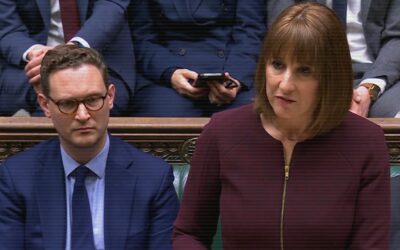At the end of the week of the political party manifestos for next month’s UK General Election, the TaxWatch team have been looking through the various pledges concerning tax from a compliance and administration lens and summarise our thoughts below.
Labour Party
All of Labour’s tax proposals had been preannounced in some way before the manifesto launch, and there are relatively few policies contained within it on which to comment on solely from a compliance and administration perspective. It is notable that changes to headline rates (for the largest taxes in terms of Government revenues: Income Tax, National Insurance, VAT and Corporation Tax) have been ruled out in advance.
The major business tax proposal relates to the windfall tax for oil and gas companies extracting hydrocarbons from the UK and its territorial waters, the Energy Profits Levy. Under a Labour Government this would be in place for the whole of the next parliament (a one year extension to its current sunset clause for 2028-29), a 3 percentage point increase in the headline rate (to 78%) and abolishing the investment allowances that allow companies to offset capital investment for tax purposes on which TaxWatch commented on last Autumn. Labour have costed this package of measures as raising £1.2bn per annum on average through the 5 year Parliament but this would be very uncertain given volatile profitability for the sector and the impact on investment in response to the tax changes.
The other major tax proposal in Labour’s published manifesto relates to private schools. A Labour led Government would make early moves to bring private school fees within the scope of VAT at the standard (20%) rate, and remove the exemption from business rates for land and buildings operated by the independent schools sector. Whilst this would need targeted anti avoidance provisions to ensure that the VAT is collected with effect from the date set in legislation, we expect work on this to be well advanced given the work of other commentators. Applying Business Rates to these properties will require Valuation Office Agency work to be carried out but should be straightforward. Together these measures have been costed to raise £1.5bn per annum.
In revenue terms the largest amount of tax yield (£5.2bn by 2028-29) in Labour’s plans is the combined package of tightening up of the reforms to the ‘non-dom’ regime alongside £855m pa investment plan to ‘modernise HMRC and change the law to tackle tax avoidance.’ Whilst it remains to be seen whether the return on investment into HMRC comes through as expected, TaxWatch has been campaigning for steady additional resources into the department for a considerable time and so welcome that a consensus has emerged on this aspect.
Of principal concern to TaxWatch in relation to the party’s manifesto is the lack of detail about how a Labour led Government would respond to a deteriorating public finance outlook, having ruled out a substantial number of options to raise additional revenues. When looking at the manifesto the areas of most interest are those that are missing from the document. There are a number of areas of tax compliance that Labour do not have a stated position on, be it the various reliefs and incentives within the business and personal tax regimes, or more fundamental (but long overdue) reforms to how some of the individual taxes could operate differently to raise additional revenues or treat taxpayers in more similar ways. There is a mooted replacement to the current system of business rates to raise the same revenue but in a ‘fairer’ way but no published detail about how that will be delivered – reforming the UK’s property taxation has proved time and time again to be uniquely politically sensitive.
Conservative Party
From compliance perspective, the Conservatives has pledged to raise additional taxes by tackling the tax gap, to the tune of £2 billion in 2025-26, increasing to £6 billion in 2029-30. There are no pledges to increase resources for HMRC to deliver these additional revenues, and with HMRC being an unprotected department for public spending purposes their operating budget will be subject to real terms cuts in the period. TaxWatch finds it implausible that these additional revenues should be relied upon to fund the equivalent pledges to cut personal taxes throughout the next Parliament.
The Conservatives have pledged not to increase rates for Income Tax, Capital Gains Tax, VAT and Stamp Duty Land Tax (except making the SDLT threshold for first time buyers £425,000 in all cases, removing the current restriction on the value of the property being purchased of £625,000).
The manifesto confirms an earlier pledge to continue to cut NIC rates for both employees (Class 1 Primary) and the complete phasing out for the self-employed (Class 4). However, within this plan, and to date there have been no decreases in employers’ (Class 1 secondary) NIC which we assume will remain in place whichever party wins the election. Cuts to NIC for the self employed further exacerbate the tax incentives to disguise employee/ employer working arrangements as representing self employment with significant compliance implications for HMRC. There is no evidence that these secondary effects have been considered or costed appropriately, and the immediate revenue impact of the reductions are extremely high, especially in relation to the frozen income tax and national insurance contribution thresholds for the working age population.
We published a blog discussing the Conservative pledge to re-introduce an age related personal allowance for income tax purposes of those above state pension age a fortnight ago which can be read here.
The ‘best’ of the rest
The smaller Westminster parties are unlikely to form a Government, except maybe as a junior coalition partner to one of the two main parties if Labour or Conservatives fail to secure a workable parliamentary majority to govern alone. However there are some interesting elements within their manifestos that are worth drawing out, and a few more radical ideas that present some implementation problems. They are considered in no particular order.
Given limited devolved responsibilities for tax in Scotland, Wales and Northern Ireland (NI) and the fact that the regional parties don’t contest seats outside of their devolved nations we haven’t looked at the manifestos for the Scottish National Party (SNP), Plaid Cymru or the NI parties.
In this section we analyse the tax proposals of the Liberal Democrats, Green Party and Reform UK Party. Their proposals vary in terms of both intent, with both the LibDems and Greens looking to increase taxes, with Reform proposing tax cuts, and the level of detail provided. The LibDems provide the most detailed proposals, with the Greens and Reform using broad brush strokes to set out their proposals.
The LibDems propose several changes to business taxes, with new levies on top of UK corporation tax such as a new ‘sewage tax’ on water company profits, an equivalent levy for tobacco firms, a substantial increase in Digital Services Tax (see our separate blog on DST), and the Bank Levy/Surcharge, plus increases to the windfall tax for the oil and gas sector and reforms to aviation taxation. Whilst these may increase tax proceeds, one of the major issues in developing new taxes is ensuring that the proper mechanisms are in place, firstly to define the base of such taxes, and also ensure that HMRC has the capacity and resources to collect the revenues without inordinate complexity that undermines the effort or delays the operation of the new taxes.
In this respect TaxWatch welcomes the additional investment in HMRC proposed by the LibDems, with an additional £1bn per year being promised, although the additional funds appear to be aimed at reducing the ‘tax gap’, clamping down on avoidance within the current tax regime, rather than enabling the development and implementation of these proposed new taxes.
Both the LibDems and Green Party have pledged to increase the capital gains rate to more closely match the higher rates for income tax on earnings, which should reduce the compliance issues prevalent within the existing regime where taxpayers attempt to recharacterize income as capital gains. Whilst the Green Party proposals are a little vague on how they would do this, the Liberal Democrats provide a more detailed analysis, suggesting the tax rate on capital gains would be dependent only on the size of the gains made in a tax year (as opposed to how much of the basic rate income tax band the individual has remaining at the moment) with gains of up to £50,000 being subject to a 20% rate, a 45% rate applying for gains above £100,000 and a 40% rate between these thresholds[1]. This is an interesting and novel approach but wouldn’t result in more CGT to pay in all circumstances. They also propose a tax free allowance for inflation, which could operate similarly to Indexation Allowance for corporate chargeable gains prior to abolition in 2018, which would reduce the size of capital gains on assets held for longer periods of time. The yield generated by the proposal is very difficult to estimate given the chance that assets standing at a large gain which could be sold quickly would be before such a tax could be legislated if the saving for the asset owner was significant enough.
A number of interesting technical points were also included within the LibDem manifesto (although have not been costed in the appendix document) that have significant implications for tax administration and compliance. Most notably a commitment to end ‘retrospective tax changes such as the loan charge and review IR35 reforms to ensure self-employed people are treated fairly’. Given both ‘IR35’ and the loan charge are attempts to police the boundary between employment status and collect revenue lost to the use of intermediaries, if changes are made to either or both of these areas there will definitely be an impact on enforcement and compliance, with an increase in the tax gap for employment taxes. See below for comments about Reform UK abolishing IR35.
Amongst all of the proposals across all the manifestos, two Green Party proposals stand out, the new wealth and carbon taxes. Carbon taxes are already in place in many European countries, but not in the UK, the Green Party’s is the only manifesto to propose a carbon tax. Unfortunately, details of how the tax would work are not included in the manifesto but additional information obtained by Tax Policy Associates suggests that the policy is not ‘border adjusted’, meaning that it would tax exported as well as imported and domestic emissions, unlike many existing carbon taxes. This approach may undermine the effectiveness of the tax in the UK, as it could lead to emissions being relocated to other territories, rather than acting as a means of reducing overall global emissions. Whilst carbon taxes undoubtedly have a role to play in reducing carbon emissions, this appears to be an area where the Green Party should have a better understanding of the potential behavioural impacts of their proposals.
The proposed Wealth Tax focuses on individuals with (extremely, in comparison to wealth taxes already in place in France and Spain[2]) high levels of wealth – starting at £10m. Irrespective of the thresholds, the taxation of wealth raises compliance and administration issues, as it is often difficult to track and accurately value specific assets often held by the wealthy, such as shares in private companies which fluctuate over time, or might be held offshore. Such a new tax would require a great deal of HMRC resources being spent on ascertaining and arguing over an individual’s wealth, making administration of the tax expensive and time consuming. The Green Party also needs to consider how tax would be collected, particularly where wealth is ‘tied up’ and may not be liquid enough to pay the tax when it is due (although given that the threshold is so high, this might be less of an issue given the small numbers of taxpayers affected).
Reform UK’s manifesto[3] in the only one which makes a specific mention of the complexity of the UK tax regime and the need for and desire to achieve simplification. We would note that the problem with Reform’s pledge is that elsewhere within the manifesto there are a great many proposals most of which would make the regime more complex. Additionally, ‘simplification’ can be achieved in two ways – either to remove distortions of treatment which generally can be abused (less tax or higher compliance resources needed to police the boundaries) – the changes that TaxWatch broadly support. The alternative simplification is removing safety nets that keep the tax regime whole and protect revenue from abuse. Reform’s proposal to abolish IR35 rules represent the latter.
There are areas of significant confusion within the proposals – an example of which is the stated benefit of the abolition of IR35 to “support sole traders [who] often work longer hours and take more risks… Many have no pension and receive no sick pay”. The welfare and state pension entitlements of the self employed barely differ from those of employees. IR35 rules don’t affect sole traders as they are designed to prevent disguised remuneration arrangements via an intermediary. The cost of removing this safeguard has not been costed, but would be very significant.
Reform also suggest other tax cuts which are notable from a compliance perspective such as increasing the VAT threshold for businesses to £120,000 (from its current frozen level of £90,000), to “free up small entrepreneurs from red tape”. This mandatory registration threshold is one of the sharpest cliff edges within the UK tax regime and has been shown to hold down growth of small businesses and contribute to under declarations of turnover. Proposals to shift that cliff edge rather than smooth its effect worsen tax compliance for the rest of businesses who operate VAT truthfully.
Another Reform proposal is to introduce a minimum profit threshold for Corporation Tax so that companies whose taxable profits are below £100,000 would be exempt. This is in addition to a phased reduction in corporation tax rates (from 25% currently down to 15% by 2030). It is not clear how this will be paid for, why it would be desirable to remove company profits from the scope of corporation tax, or how the exemption would work for companies whose profitability is volatile.
So, where does this the main battle between the Labour and Conservative Parties…?
Given the overwhelming need to reform and simplify the UK tax regime in the next Parliament it is disappointing that both main parties demonstrate a lack of well thought out ideas and proposals for change to reduce the scope of avoidance and simplify administration for HMRC and taxpayers of all types.
It’s far from clear how either of the main parties would change UK taxation if, as is likely, there is a need to raise additional revenues or re-distribute the taxes to support growth or rebalance between levies on incomes, wealth, and consumption.
[1] The details are not included in the manifesto, but in the press release, which was not made publicly available, but which Dan Neidle reported on: Our take on the Lib Dem manifesto – Tax Policy Associates
[2] €1.3 million in France, but the wealth tax only covers real estate and €3 million in Spain.
[3] Interestingly this has been framed as a draft ‘contract’ for debate, rather than a manifesto (it’s not clear to TaxWatch the relevance of this distinction).



